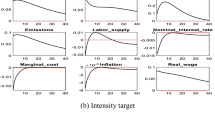Abstract
Observed changes in weather can reveal marginal impacts of climate change on economic outcomes and the potential for adaptation. When modeling the nonlinear relationship between weather and changes in economic outcomes empirically, model choice can confound the interpretation of marginal and percentage effects and their respective confidence intervals. I present a simple solution for better characterizing semi-elasticities of nonlinear climate damages, and evaluate its relevance in interpreting empirical climate damages. For small marginal effects, the implications of this interpretation error is small; for larger effects, however, the misinterpretation error can be substantial.



Similar content being viewed by others
Notes
This framework extends to models with any logarithmic dependent variable.
Alternatively, this equation could represent the effect of growing degree days on log agricultural yields, or the number of days above 90 °F on the log mortality rate.
Formally, g = [Y (D i t = 1) − Y (D i t = 0)] /Y (D i t = 0).
Note that \(\hat {g}\) and \(\hat {\beta }\) need not be equivalent at \(\hat {\beta }= 0\) because of the variance estimate that scales \(\hat {g}\). For the purpose of this figure, I set \(\hat {V}(\hat {\beta })= 0\) for \(\hat {\beta }= 0\) (see van Garderen and Shah (2002) for further discussion).
For details on the specification of BHM main regression results, see their supplementary information section B.1.
See Burke et al. (2015) for details. Replication code and data was accessed from: https://purl.stanford.edu/wb587wt4560https://purl.stanford.edu/wb587wt4560 (Last accessed: Feb. 7, 2017).
References
Barreca A, Clay K, Deschênes O, Greenstone M, Shapiro JS (2015) Convergence in adaptation to climate change: evidence from high temperatures and mortality, 1900–2004. Am Econ Rev 105(5):247–251
Barreca A, Clay K, Deschenes O, Greenstone M, Shapiro JS (2016) Adapting to climate change: the remarkable decline in the US temperature-mortality relationship over the twentieth century. J Polit Econ 124(1):105–159
Burke M, Emerick K (2016) Adaptation to climate change: evidence from US agriculture. Am Econ J Econ Pol 8(3):106–40
Burke M, Hsiang SM, Miguel E (2015) Global non-linear effect of temperature on economic production. Nature 527(7577):235–239
Carleton TA, Hsiang SM (2016) Social and economic impacts of climate. Science 353(6304)
Chan NW, Wichman CJ (2017) The effects of climate on leisure demand: evidence from North America. Working Paper Version: December 5
Dell M, Jones BF, Olken BA (2012) Temperature shocks and economic growth: evidence from the last half century. Am Econ J Macroecon 4(3):66–95
Dell M, Jones BF, Olken BA (2014) What do we learn from the weather? The new climate–economy literature. J Econ Lit 52(3):740–798
Deryugina T, Hsiang SM (2014) Does the environment still matter? Daily temperature and income in the United States. Technical Report, National Bureau of Economic Research
Halvorsen R, Palmquist R (1980) The interpretation of dummy variables in semilogarithmic equations. Am Econ Rev 70(3):474–75
Kennedy PE (1981) Estimation with correctly interpreted dummy variables in semilogarithmic equations. Am Econ Rev 71(4)
Schlenker W, Roberts MJ (2006) Nonlinear effects of weather on corn yields. Appl Econ Perspect Policy 28(3):391–398
Schlenker W, Roberts MJ (2009) Nonlinear temperature effects indicate severe damages to US crop yields under climate change. Proc Natl Acad Sci 106(37):15594–15598
van Garderen KJ, Shah C (2002) Exact interpretation of dummy variables in semilogarithmic equations. Econ J 5(1):149–159
Author information
Authors and Affiliations
Corresponding author
Rights and permissions
About this article
Cite this article
Wichman, C.J. Interpreting nonlinear semi-elasticities in reduced-form climate damage estimation. Climatic Change 148, 641–648 (2018). https://doi.org/10.1007/s10584-018-2197-z
Received:
Accepted:
Published:
Issue Date:
DOI: https://doi.org/10.1007/s10584-018-2197-z




